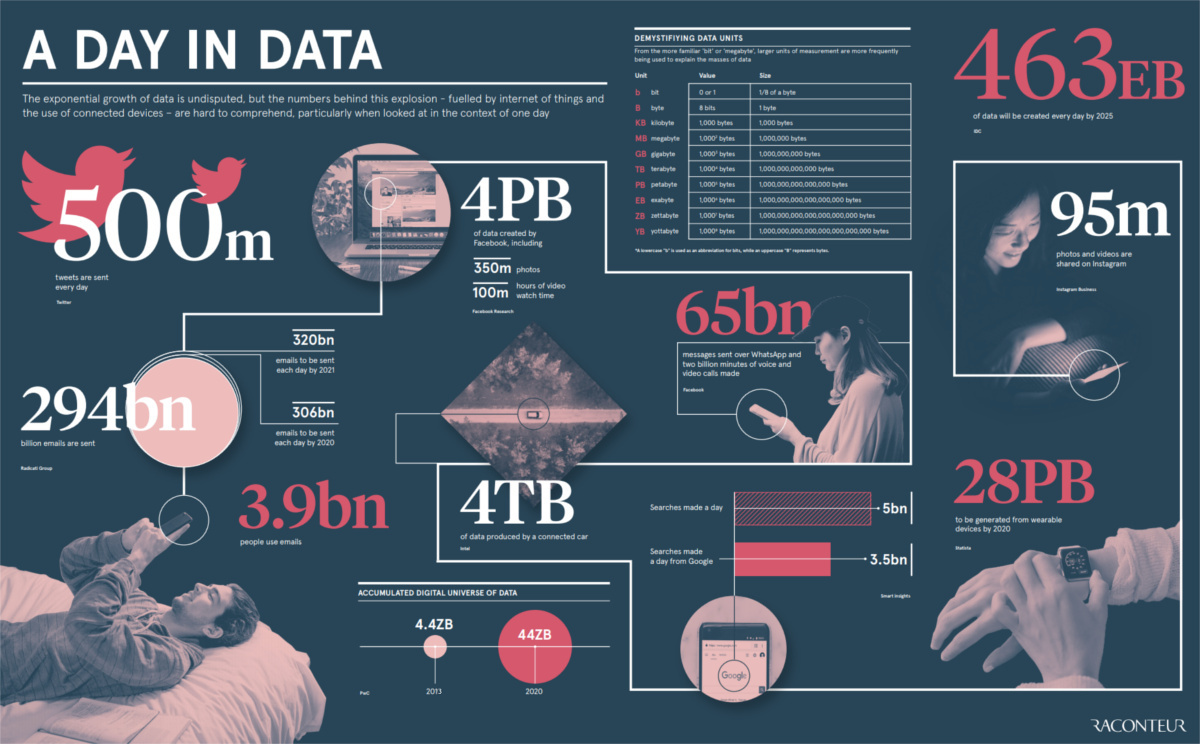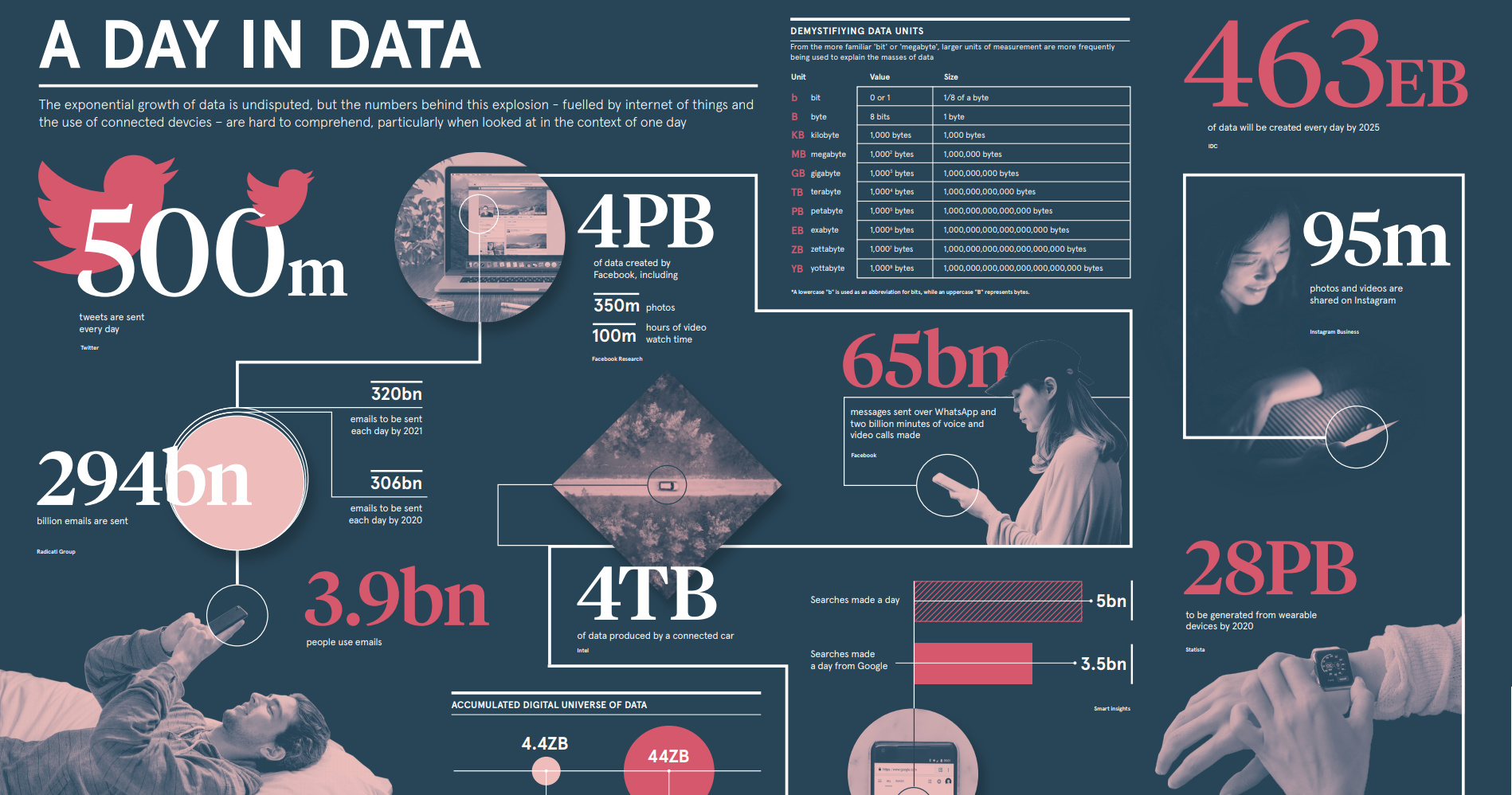Technology
How Much Data is Generated Each Day?
View the full-size version of the infographic
How Much Data is Generated Each Day?
View the full-size version of the infographic by clicking here
You’ve probably heard of kilobytes, megabytes, gigabytes, or even terabytes.
These data units are common everyday amounts that the average person may run into. Units this size may be big enough to quantify the amount of data sent in an email attachment, or the data stored on a hard drive, for example.
In the coming years, however, these common units will begin to seem more quaint – that’s because the entire digital universe is expected to reach 44 zettabytes by 2020.
If this number is correct, it will mean there are 40 times more bytes than there are stars in the observable universe.
A Crash Course in Data
Today’s infographic comes to us from Raconteur, and it gives us a picture of this new data reality.
Before we get to how much data is created each day – both now, and in the future – it’s worth getting acquainted with how data scales in terms of units.
| Abbreviation | Unit | Value | Size (in bytes) |
|---|---|---|---|
| b | bit | 0 or 1 | 1/8 of a byte |
| B | bytes | 8 bits | 1 byte |
| KB | kilobytes | 1,000 bytes | 1,000 bytes |
| MB | megabyte | 1,000² bytes | 1,000,000 bytes |
| GB | gigabyte | 1,000³ bytes | 1,000,000,000 bytes |
| TB | terabyte | 1,000⁴ bytes | 1,000,000,000,000 bytes |
| PB | petabyte | 1,000⁵ bytes | 1,000,000,000,000,000 bytes |
| EB | exabyte | 1,000⁶ bytes | 1,000,000,000,000,000,000 bytes |
| ZB | zettabyte | 1,000⁷ bytes | 1,000,000,000,000,000,000,000 bytes |
| YB | yottabyte | 1,000⁸ bytes | 1,000,000,000,000,000,000,000,000 bytes |
There’s no doubt that data literacy will only become more important in the future, so make sure you know your zettabytes from your yottabytes!
A Day of Data
How much data is generated in a day – and what could this look like as we enter an even more data-driven future?
Here are some key daily statistics highlighted in the infographic:
- 500 million tweets are sent
- 294 billion emails are sent
- 4 petabytes of data are created on Facebook
- 4 terabytes of data are created from each connected car
- 65 billion messages are sent on WhatsApp
- 5 billion searches are made
By 2025, it’s estimated that 463 exabytes of data will be created each day globally – that’s the equivalent of 212,765,957 DVDs per day!
If you think the above information is fascinating, see what happens in an internet minute.
Technology
Visualizing AI Patents by Country
See which countries have been granted the most AI patents each year, from 2012 to 2022.

Visualizing AI Patents by Country
This was originally posted on our Voronoi app. Download the app for free on iOS or Android and discover incredible data-driven charts from a variety of trusted sources.
This infographic shows the number of AI-related patents granted each year from 2010 to 2022 (latest data available). These figures come from the Center for Security and Emerging Technology (CSET), accessed via Stanford University’s 2024 AI Index Report.
From this data, we can see that China first overtook the U.S. in 2013. Since then, the country has seen enormous growth in the number of AI patents granted each year.
| Year | China | EU and UK | U.S. | RoW | Global Total |
|---|---|---|---|---|---|
| 2010 | 307 | 137 | 984 | 571 | 1,999 |
| 2011 | 516 | 129 | 980 | 581 | 2,206 |
| 2012 | 926 | 112 | 950 | 660 | 2,648 |
| 2013 | 1,035 | 91 | 970 | 627 | 2,723 |
| 2014 | 1,278 | 97 | 1,078 | 667 | 3,120 |
| 2015 | 1,721 | 110 | 1,135 | 539 | 3,505 |
| 2016 | 1,621 | 128 | 1,298 | 714 | 3,761 |
| 2017 | 2,428 | 144 | 1,489 | 1,075 | 5,136 |
| 2018 | 4,741 | 155 | 1,674 | 1,574 | 8,144 |
| 2019 | 9,530 | 322 | 3,211 | 2,720 | 15,783 |
| 2020 | 13,071 | 406 | 5,441 | 4,455 | 23,373 |
| 2021 | 21,907 | 623 | 8,219 | 7,519 | 38,268 |
| 2022 | 35,315 | 1,173 | 12,077 | 13,699 | 62,264 |
In 2022, China was granted more patents than every other country combined.
While this suggests that the country is very active in researching the field of artificial intelligence, it doesn’t necessarily mean that China is the farthest in terms of capability.
Key Facts About AI Patents
According to CSET, AI patents relate to mathematical relationships and algorithms, which are considered abstract ideas under patent law. They can also have different meaning, depending on where they are filed.
In the U.S., AI patenting is concentrated amongst large companies including IBM, Microsoft, and Google. On the other hand, AI patenting in China is more distributed across government organizations, universities, and tech firms (e.g. Tencent).
In terms of focus area, China’s patents are typically related to computer vision, a field of AI that enables computers and systems to interpret visual data and inputs. Meanwhile America’s efforts are more evenly distributed across research fields.
Learn More About AI From Visual Capitalist
If you want to see more data visualizations on artificial intelligence, check out this graphic that shows which job departments will be impacted by AI the most.
-

 Markets1 week ago
Markets1 week agoU.S. Debt Interest Payments Reach $1 Trillion
-

 Markets2 weeks ago
Markets2 weeks agoRanked: The Most Valuable Housing Markets in America
-

 Money2 weeks ago
Money2 weeks agoWhich States Have the Highest Minimum Wage in America?
-

 AI2 weeks ago
AI2 weeks agoRanked: Semiconductor Companies by Industry Revenue Share
-

 Markets2 weeks ago
Markets2 weeks agoRanked: The World’s Top Flight Routes, by Revenue
-

 Countries2 weeks ago
Countries2 weeks agoPopulation Projections: The World’s 6 Largest Countries in 2075
-

 Markets2 weeks ago
Markets2 weeks agoThe Top 10 States by Real GDP Growth in 2023
-

 Money2 weeks ago
Money2 weeks agoThe Smallest Gender Wage Gaps in OECD Countries
















